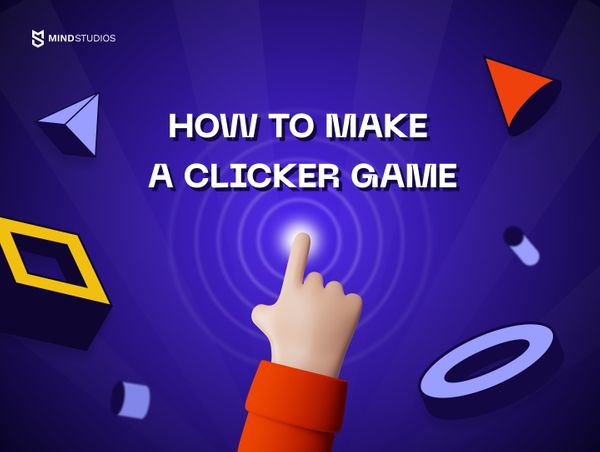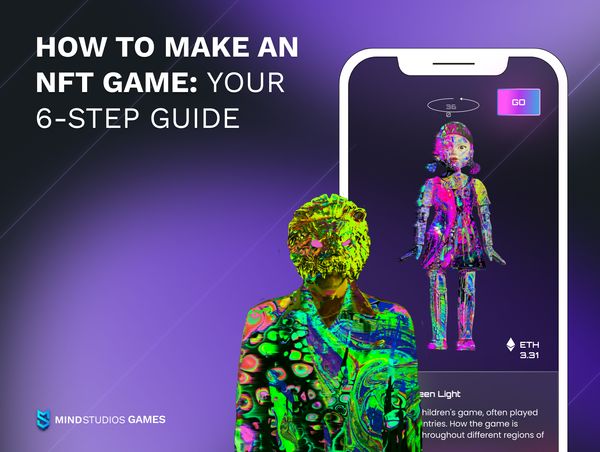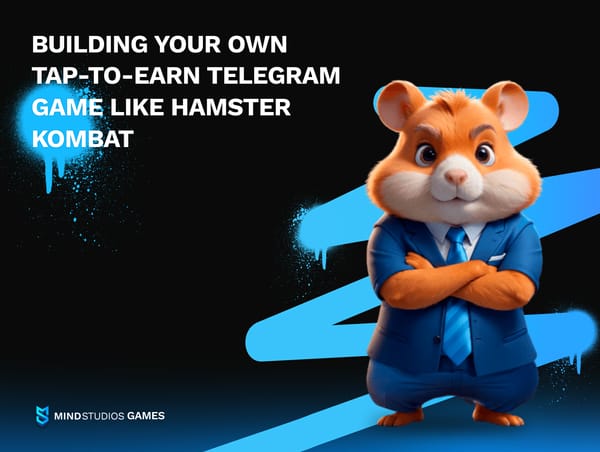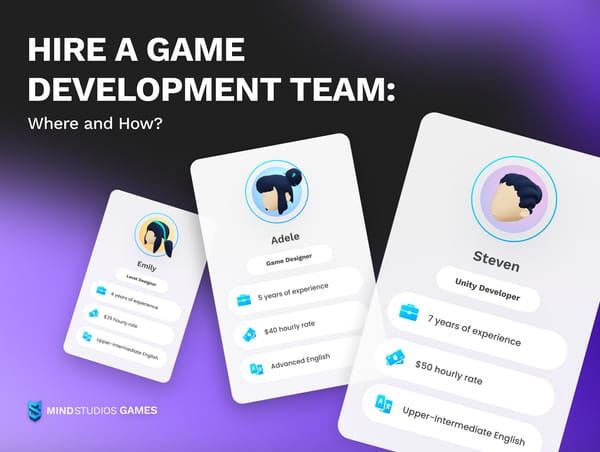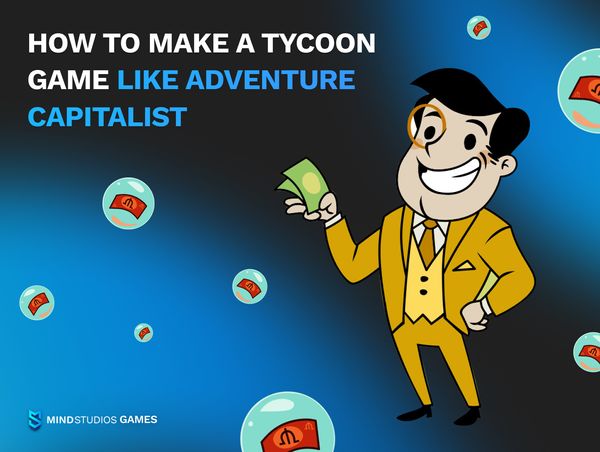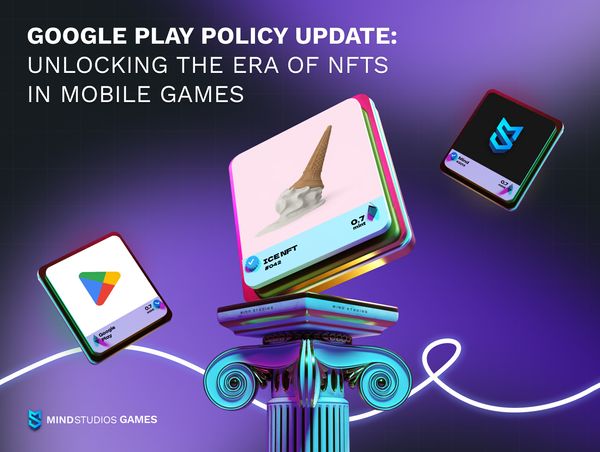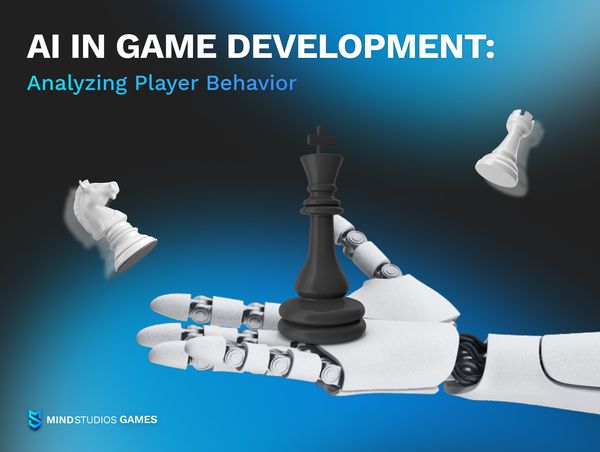The sudden popularity of Hamster Kombat earlier this year gave rise to interest in Telegram game development. Mind Studios games tried our hand in this trend and here’s what we have to say about how to make a game for Telegram.
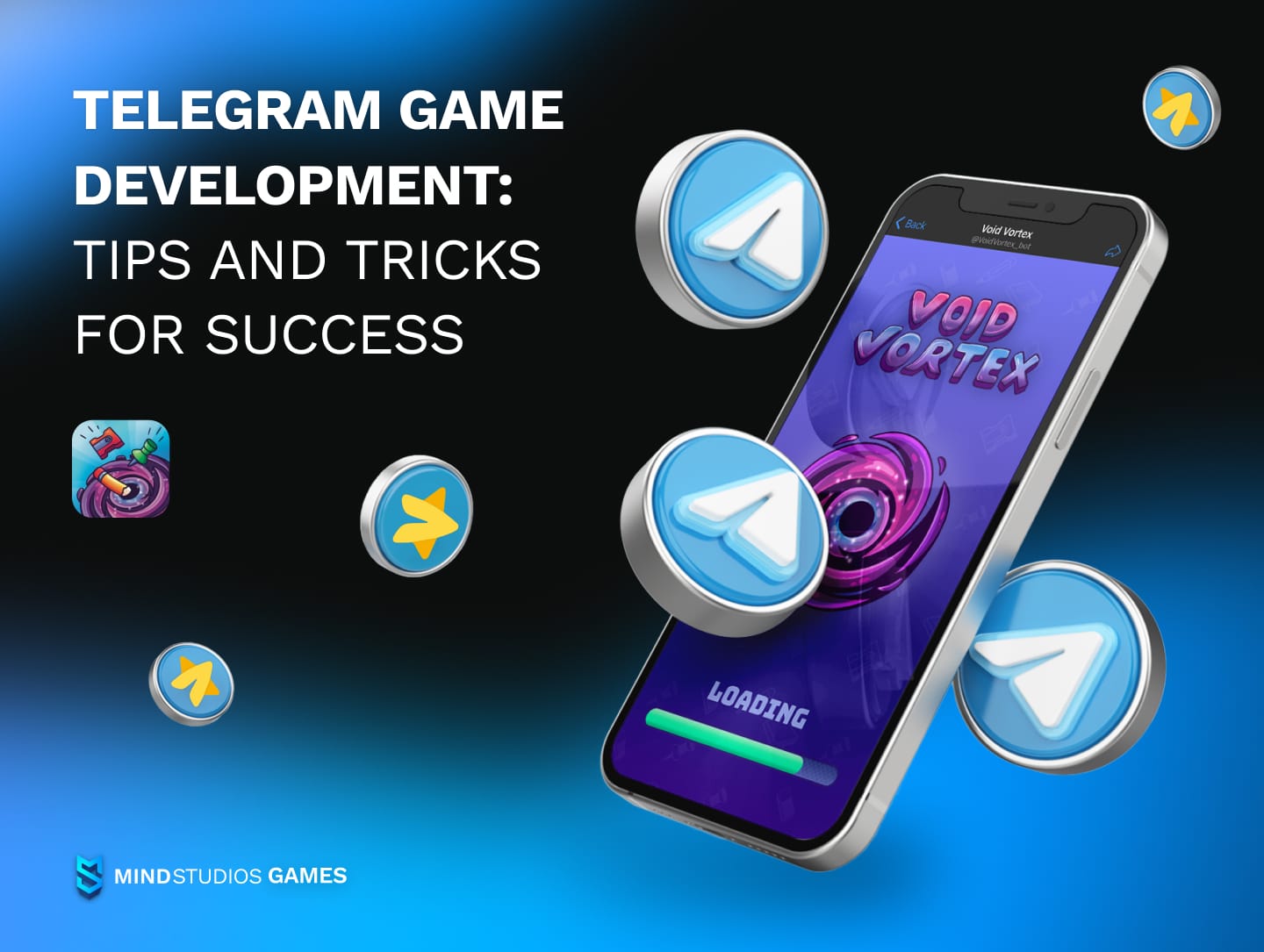
Telegram introduced the opportunity to launch games inside the messenger ecosystem quite a long time ago, in October 2016, as part of their Bot Platform 2.0 update. So it’s not exactly a new thing. The recent boom of interest in creating games for Telegram is — at least partially — attributed to the app’s launch of an in-app browser with native support for crypto and decentralized sites. The lists of most popular Telegram games are dominated by play-to-earn crypto-based titles.
At Mind Studios Games, we’ve built our own Telegram game — mostly to see if we can 😅 And sure enough, we can! 😎 It’s called Void Vortex, and it’s a 3D hyper-casual game where you try to squeeze in as many objects into a void hole as you can; the more objects you get to fall in, the bigger the hole becomes. You can try it here.
Below, we’ll explain how to make a game for Telegram. And if you’re looking for a skilled team to build a Telegram game for you, drop us a line — Mind Studios Games offers both full-cycle development with a dedicated team and separate specialists your existing team might be lacking.
Telegram games explained: Features and benefits
Telegram is very much on its way to becoming a super-app like WeChat — it’s more than just a messenger already. With the latest update, which included a native browser with cryptocurrency support, it’s also become a popular platform for idle and hyper-casual play-to-earn games from crypto platforms.
What is a Telegram game, exactly?
Telegram games are lightweight, and usually pretty simple games, launched via a Telegram bot and played in the Telegram’s built-in browser. Since they’re browser games, players don’t need to install them on devices, which is a significant perk.
How are Telegram games made?
Well, a lot of Telegram games are coded in HTML5, meaning they’re basically web pages. Hamster Kombat itself is built using HTML5, as are some other titles that had an influx of users this summer: Lumberjack, Corsairs, 2048.
However, it’s also possible to integrate into the Telegram platform a game made with Unity’s WebGL feature — we know because that’s exactly what we did, our Void Vortex game is made with Unity. If you’d like to hear about a more well-known title, there’s Meme TD, a tower defense game on Telegram’s TON and revolving around popular memes. It was also built with Unity WebGL.
What’s the difference? Complexity of gameplay, mainly. HTML5 produce code for web-based games, and their range of features, while not exactly narrow, still can’t compete with those in game engines. Granted, a game built in Unity for a messenger like Telegram will also have limitations compared to installable mobile games. After all, you will need to integrate the game into the Telegram bot and play via its in-built browser. But the selection of possible features is still wider than with web frameworks.
Concept development
Same as with any other video games, Telegram game development also starts with a concept. Telegram is not overly saturated with games currently, so standing out might be easier than on some other platforms. However, players won’t play a boring game just because it’s the only one available. So you need to make it interesting.
Now, Telegram as a gaming platform does have its strengths — for example, its large user base, bots, and instant access for players without app installation. But also has limitations, which you need to consider when aiming for it as a gaming platform. To achieve success on a messaging platform, a game needs to be two things, before anything else:
#1 Light
Telegram game integration is done via bots and games are played in a Telegram’s in-built browser, as we’ve already mentioned, and the browser won’t be able to handle resource-heavy games easily. Remember that these games are essentially web pages, even those made with Unity.
#2 Simple
Players won’t engage in a fast-paced and resource-heavy game in a messenger, it’s not the main purpose of the app. We have actual native games for that. Telegram games are made for short, fast sessions between messaging — they need to load instantly, react to players’ actions with ease, and not require long sessions. Idle and hyper-casual games are best suited for that; turn-based games are another option.
This narrowing down to two main principles might seem restrictive, but in reality, you still have a lot of option where to direct your Telegram game. The selection of settings is the same as for any other game — you can make it a chat quiz, or you can take players to space — to shoot at alien ships and protect the Earth, or to colonize the universe. And everything in between.
We’ll talk about mechanics in a section below, for now just know your options in that department are also quite wide.
That’s one of the reasons many existing mobile games are being ported to Telegram these days, and copies of popular titles are created. For example, Lumberjack, one of the popular play-to-earn Telegram games, seems to be based off a mobile game Timberman released quite long ago, in 2014.
If you’d like a professional assessment and advice on the viability and marketability of your concept when creating games for Telegram, contact our team: we provide both development and consulting services.
Tools and technologies for Telegram game development
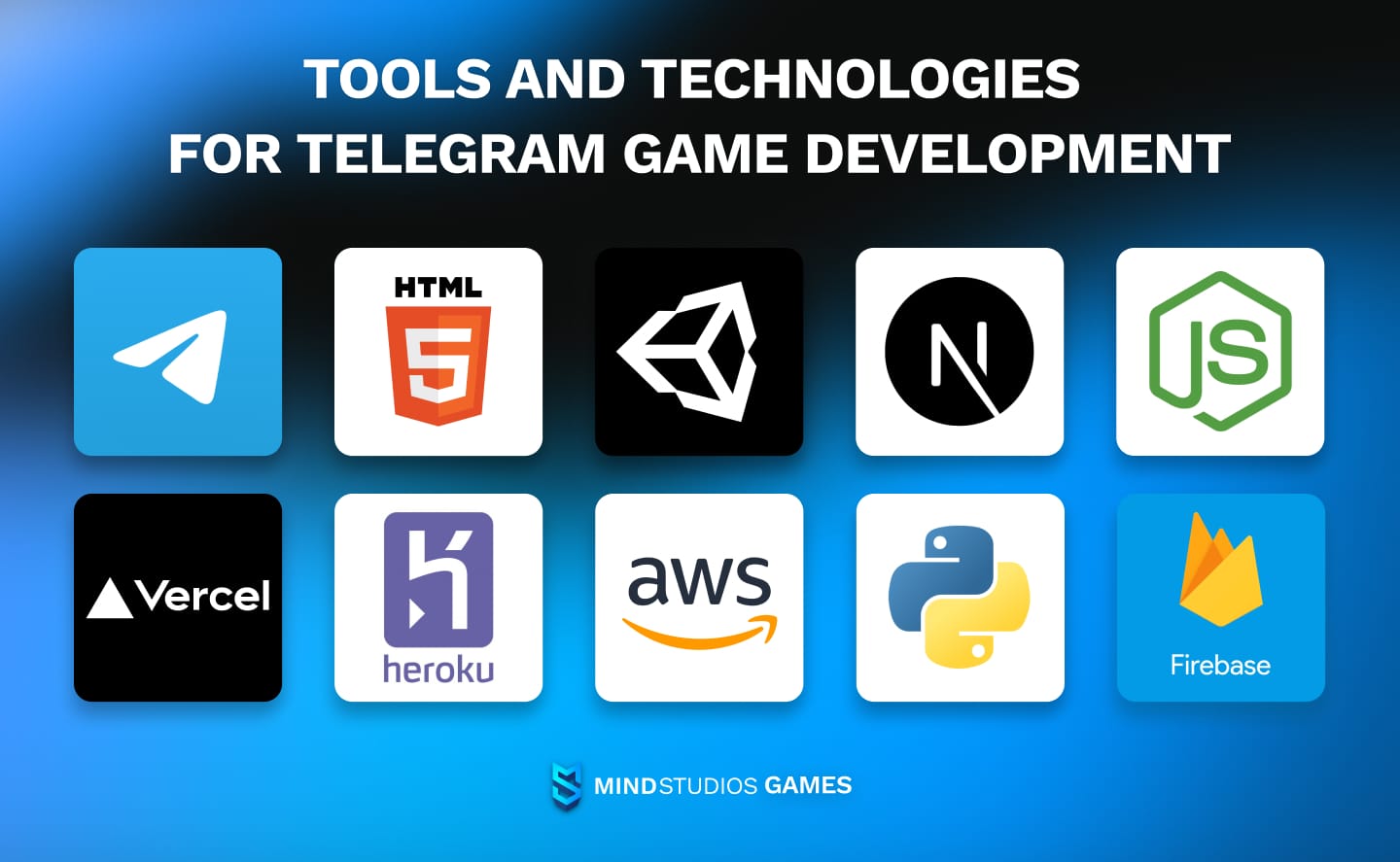
If you don’t yet know how to create a game for Telegram, we’ve researched the topic when we decided to create Void Vortex. Here, we’ll share a list of tools we’d recommend to anyone starting on the journey.
Official Telegram tools
- Telegram Bot API allows developers to interact with Telegram servers, manage bot actions, and send/receive messages. You can use this API to create commands, handle user interactions, and manage game sessions.
- Telegram Gaming Platform allows embedding HTML5 (and Unity WebGL) games into Telegram and offers real-time interaction with bot commands.
- Telegram Bot Libraries — frameworks that automate much of the low-level Telegram Bot API calls and make development faster: Telethon (a Python asynchronous Telegram client library for building bots) and GramJS (a Node.js client for more complex bot functions).
HTML5 game development tools
Since Telegram supports embedding web-based games within bots, you can use HTML, JavaScript, and CSS to build responsive, interactive games. HTML5 is the core technology used for Telegram gaming bots development. The main tools we’d recommend are:
- HTML5, JavaScript, and CSS. The straightforward way to develop HTML5-supported games. However, it requires a bit more effort to manage game logic, rendering, and interactivity compared to other options.
- Unity WebGL, a Unity tool for creating games that run in a browser. You’ll be publishing your game as a JavaScript program.
- Phaser.js, fast, open-source HTML5 game framework for building 2D games.
- PixiJS, a 2D rendering engine that can be used with HTML5 games.
- Construct, a 2D no-code game engine.
Backend tools
Popular backend programming languages for developing Telegram bots include Python and Node.js, but it’s also possible to integrate a game into the Telegram bot with a Ruby-on-Rails backend or server-as-a-service Firebase.
Game hosting
For Telegram game development, hosting services should offer easy deployment, scalability, and real-time performance. There are several options that satisfy these requirements one way or another.
- Heroku. Best for prototyping and smaller-scale games, especially ones with low player traffic, since it has latency issues. However, it has free tier for small projects, is simple when it comes to setup, and it integrates well with Git for continuous deployment.
- Vercel. Great for hosting browser-based games with minimal back-end logic (since it has limited server-side functionality). It’s also free for hobby projects.
- AWS Lambda and DynamoDB. Amazon Web Services offer serverless approach, which reduces management workload, and its costs only are charged per usage. It’s also great at handling spikes in demand. However, it has a learning curve, you’d better have an experienced team if you choose this option.
- Cloud or dedicated server with a more manual set up. It’s possible to rent a no-software server and have a DevOps set the environment where your game will be deployed. OVH Cloud, Hetzner, or Linode could be good hosting options.
Game design and mechanics
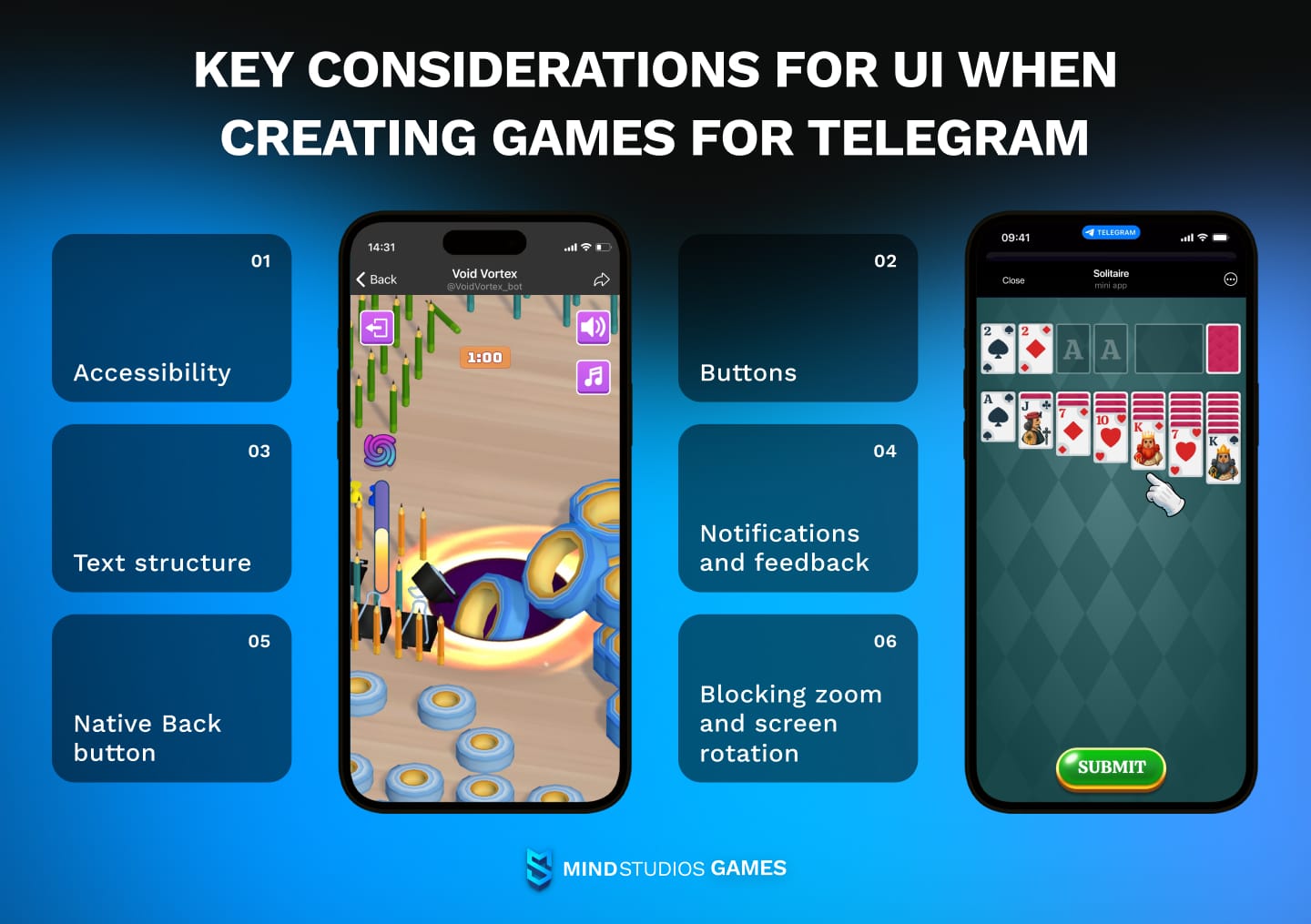
Depending on the type of game you’re planning to build, Telegram game development mechanics and UI will differ.
If we’re talking about a title like Hamster Kombat, for example, it’s a traditional idle clicker for the most part, but with play-to-earn elements. Mechanics-wise, it has a classic idle approach:
- Tap on the hamster to earn coins
- Buy boosters with coins
- Go do your daily things for a while as boosters collects coins instead of you tapping
- Come back to collect and spend coins
- Rinse and repeat as you wait for airdrop to get a chance to earn tokens
On the other hand, there are hyper-casual games like our Void Vortex, which is also quite classic mechanics-wise, but in a different genre. In it, players spend their time trying to drop as many objects into the void as possible, with each level getting more challenging. As most hyper-casual games, it also has limited mechanics and the goal is to rack up points to get on the leaderboard.
Finally, there are text-based Telegram games where players interact via chat messages or commands. For example, trivia games like Quizarium allow people in group chats to compete in general knowledge.
Key considerations for UI when creating games for Telegram:
- Accessibility. Ensure the interface works well on mobile devices, as most Telegram users access the platform via their smartphones. The text size, button placement, and ease of interaction should be optimized for touch screens. Basically, approach Telegram game development as you would mobile game development.
- Buttons. Telegram supports inline buttons, which players can use to make choices or perform actions. These should be large enough to be easily understood and minimize the number of taps required for players to progress.
- Text structure. As Telegram is a mobile messenger first and foremost, the text in your game should be concise to not take up half of the users’ screens. It should also be actionable and engaging. Avoid lengthy paragraphs, use bullet points, emojis, or icons to make instructions more readable.
- Notifications and feedback. Your game should provide instant feedback on player actions, whether through notifications, changes in score, or visual updates like GIFs or images to show progress.
- Native Back button. Telegram games are played in the in-app browser, and can have some distinct browser features. One of those would be a browser-like Back button at the top. So no need to include another similar button in your game.
- Blocking zoom and screen rotation. By default, most browsers allow easy zoom (with two fingers) and screen changing to landscape when users rotate the device. For a game, these can cause disruption, so consider blocking these features for players.
Game flow and interactions
The game flow is a term that refers to how players move through the different stages of gameplay, interact with the game, and how the story or mechanics unfold. Fun gameplay mechanics are at the heart of any game, that’s the only sure way to keep players hooked. For Telegram game development mechanics, simplicity is key, but that doesn’t mean the mechanics can’t be deep or interesting. When you design your Telegram game, take into account the following:
Key considerations for Telegram game design and flow |
|
|---|---|
| Smooth onboarding | Introduce the game mechanics gradually. Use a tutorial or demo phase to ease players into the game without overwhelming them with all the rules at once. |
| Pacing | Since Telegram games are usually played in short bursts, design the game flow to allow short, few-minutes sessions, and focus on gameplay that delivers immediate feedback. Ensure that each session feels complete or contributes to the larger progression. |
| Actionable choices | Whether it’s a turn-based game or a text adventure, players should be able to make meaningful choices. Every interaction should feel like it affects the game world or outcomes. |
| Progression loops | Players should feel like they are always moving toward a larger goal. Be it improving their character, unlocking new content, or simply earning more points, this forward momentum keeps them engaged. |
| Surprise elements | Random events, surprises, or rare bonuses add an element of spontaneity that keeps gameplay exciting. These could be random challenges, unexpected rewards, or new story developments. |
| Multiplayer interactions | Multiplayer games are inherently engaging because of the competitive or cooperative interactions, and many Telegram games allow players to compete or cooperate with friends or other users. But due to the nature of Telegram games, we recommend crafting these interactions to be asynchronous, so players don’t need to be online simultaneously. For example, players can leave challenges for others, which they can respond to when they come online. |
Scoring and reward systems
A well-designed scoring and reward system keeps players motivated and offers a sense of achievement. And poor scoring system will make your game seem unfair, creating negative feelings in players. Therefore, it’s of utmost importance to allocate ample attention to the scoring mechanics as you go about the game design for Telegram. Here are our suggestions.
- Point-based rewards. Point-based rewarding system is perhaps obvious, but it is the most suitable for games played in a messenger. Players will be earning points for completing tasks, overcoming obstacles, or making strategic choices. These points will accumulate over time, allowing players to compare progress between sessions.
- Tiers of rewards. Design a tiered system where small rewards (such as earning a few points per turn or level) are frequent, but larger rewards (e.g., unlocking a special item) require sustained effort — for example, completing several levels or earning a certain amount of points.
- Daily rewards. Telegram games can incentivize daily logins by offering small rewards for players who check in regularly. This can improve retention.
- Dynamic feedback. Reward the player with something more than just points. Congratulatory messages, animations, or special badges can enhance the feeling of accomplishment. For instance, when a player reaches a milestone, a celebratory GIF or special emoji will make players happy and thus enhance their experience.
Leaderboards
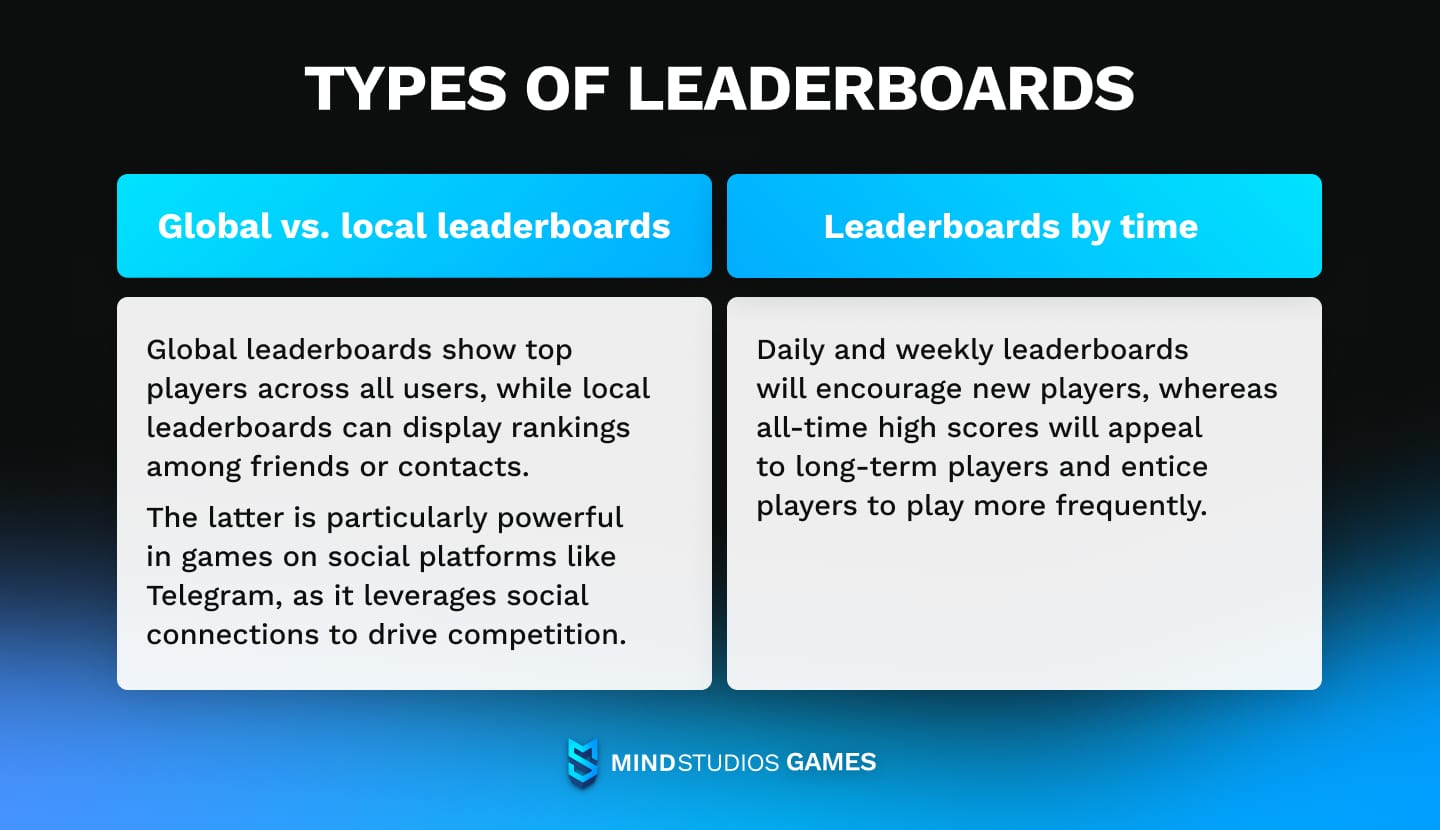
Leaderboards help foster a competitive environment, motivating players to improve their performance and strive for higher rankings even in an otherwise single-player game. There are two main types of leaderboards:
Global vs. local leaderboards |
Leaderboards by time |
|---|---|
| Global leaderboards show top players across all users, while local leaderboards can display rankings among friends or contacts. The latter is particularly powerful in games on social platforms like Telegram, as it leverages social connections to drive competition. | Daily and weekly leaderboards will encourage new players, whereas all-time high scores will appeal to long-term players and entice players to play more frequently. |
You should also set up notification systems to let players know when they climb up the leaderboard, or if someone overtakes them. Real-time updates create urgency and enhance engagement.
Balancing difficulty and player progression
Balancing the difficulty of the game is crucial when it comes to keeping players engaged without frustrating them. This is true for any game, of course. And, generally speaking, the recommendations for game balancing in Telegram game development are the same most other types of games require.
- Gradual difficulty curve. Introduce challenges in stages. Early levels should be easier to help new players learn the mechanics, while later levels should ramp up the difficulty to keep experienced players engaged.
- Adaptive difficulty. Some games use algorithms, including AI and ML ones, to adjust the difficulty based on player performance. If a player is struggling, the game could subtly reduce the difficulty, or if they’re excelling, it could introduce harder puzzles or more challenging enemies.
- Challenging but fair. Your game should be challenging enough to engage the player, but not so difficult that it becomes discouraging. Ensure players have clear pathways to improvement, such as through skill acquisition or strategic choices.
- Progression rewards. As players progress, they should gain a sense of accomplishment. Offer new abilities, unlockable content, or visual upgrades (even small ones) to make progression feel rewarding. For example, as players level up, they could unlock more complex missions or customization options.
Replayability and retention strategies
To keep players coming back, your Telegram messenger game needs mechanisms that encourage continued engagement. Here, we will list the popular ways to keep players coming back, but depending on the type of your game, your game designer should be able to recommend the best-fitting strategy.
- Daily and weekly challenges. Introduce daily or/and weekly quests that offer limited-time rewards, encouraging players to check in regularly.
- Procedurally generated content. If applicable, introduce procedural generation to create varied experiences each time players return. This is mostly effective for puzzle games, roguelikes, or quizzes.
- Social elements. Integrate social sharing, where players can share their progress, scores, or achievements with friends or groups on Telegram. These social elements can drive competitive or cooperative engagement.
- Unlockable content. Add layers of progression, where players unlock new levels, game modes, characters, or skins as they continue playing. This ensures they have something to work towards.
All this may appear like a lot to consider when you’re planning something as seemingly simple as creating games for Telegram. However, an experienced game designer and developer will be already familiar with everything we’ve listed in this section, and they’ll be able to come up with a solid plan for your Telegram gaming bots development quickly and efficiently. If you’re looking for such an experienced developer, look no further — come talk to us. Our team will walk you through all the processes from concept to launch with practiced ease 😎
Developing the game
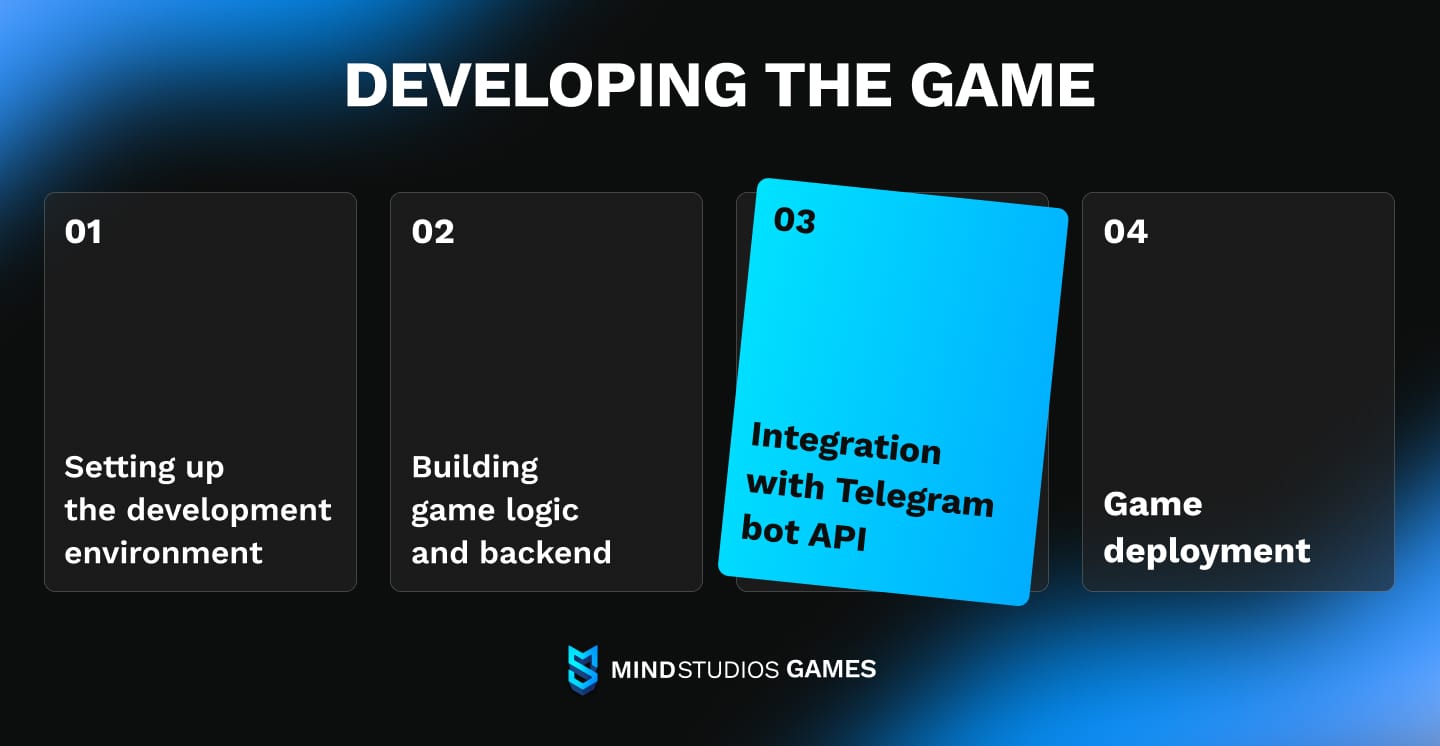
When you’re done with your concept and game design for Telegram, it’s time to start with development. The stages you (or your developers) will go through are:
- Setting up the development environment
- Building game logic and backend
- Integration with Telegram bot API
- Game deployment
Let us explain each step in short.
1. Setting up the development environment
As we’ve mentioned at the beginning of this article, you have two main options for how to make a game for Telegram:
- HTML5 game development
- Unity WebGL game development
At Mind Studios Games, we have experts in game development with HTML5 and Unity. Unity has been our go-to game engine for all our native mobile games (which are our primary focus), and even our Telegram game Void Vortex is made with Unity.
With Unity-Telegram hybrid development, Unity handles the core game logic and rendering, while Telegram is used for player interactions, notifications, and commands. You can use UnityWebRequest to communicate with the Telegram Bot API for sending and receiving messages or commands. And if you’d like to build a multiplayer turn-based game for Telegram, a Flask or Node.js webhook server can handle Telegram updates asynchronously.
Here are the steps for setting up the environment for Telegram game development when you’re creating a Unity game:
- Install Unity
- Install Telegram API Tools
- Create a Telegram Bot with a @/BotFather on Telegram
- Install a package for Unity to handle HTTP requests (UnityWebRequest is one option)
- If you plan to send players push notifications, install a Webhook
With these tools, you can proceed to the next step.
2. Building the game
Whichever you choose for your game development — HTML5 or Unity WebGL — this is the step where you’re building the game. At this stage, it really has nothing to do with Telegram specifically — you’re just creating your game the same way you usually do. Just keep in mind the limitations of the intended platform we’ve talked about above.
Unity uses C# for coding, and HTML5 games use JavaScript and CSS. For backend, you could use Python or Node.js — they’re quite popular for Telegram game development.
Always plan for thorough testing of your game for all supported platforms — Telegram even has UI differences between iOS and Android, and however slight, they might still affect your game’s performance.
3. Integration with Telegram bot API
UnityWebRequest allows you to send HTTP requests to Telegram’s Bot API to interact with players via Telegram. This includes sending messages, displaying inline buttons, or handling player input.
Connecting your backend to Telegram (to handle incoming requests) can be done via Webhooks and the commands of the Telegram bot API.
4. Game deployment
After integrating the game with Telegram, you’ll need to deploy the game. You’ll want to host your game logic on a production server (e.g., Heroku, AWS). You’ll also need to register your game using the Telegram Game Platform, set up game metadata — title, description, and callback URLs.
If you’re using Webhooks, remember to change the URL to the production one.
Launching the game
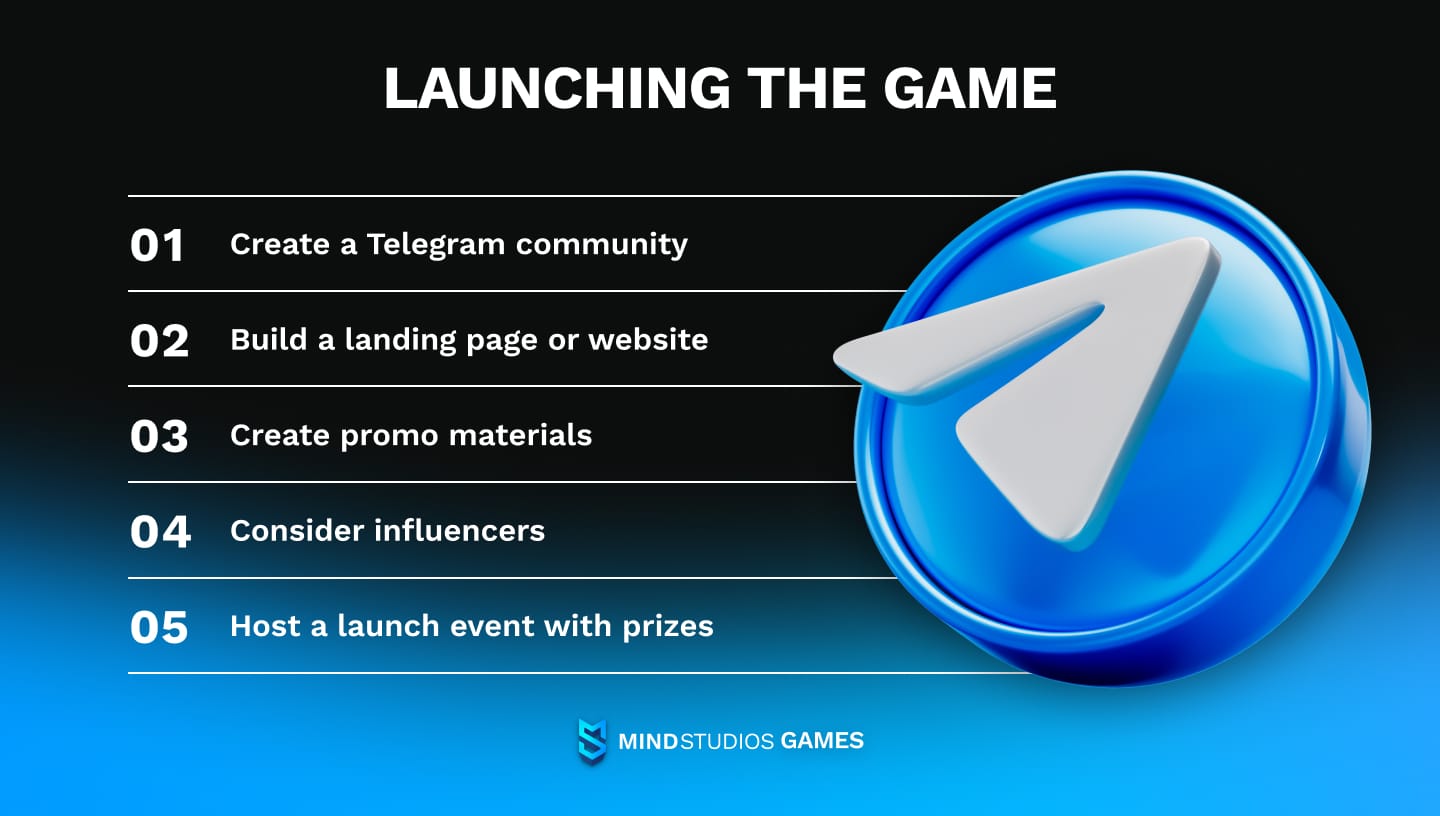
Launching and marketing a game on Telegram requires a somewhat unique approach because Telegram is both a messaging platform and a social media network before it’s a gaming space. To ensure the successful release and long-term success of your game, it’s essential to have a strategic plan from pre-launch to post-launch support.
Here’s what we recommend for pre-launch and launch prep:
- Create a Telegram community. A group for potential players to join and communicate, a channel for announcements and keeping things heated.
- Build a landing page or website. Advertising outside the Telegram platform is essential, and landing pages are a great way to do that. You can link to them from your other ad campaigns, and they can host links to all your important spaces, including invites to the Telegram groups and channels.
- Create promo materials. Teasers, trailers, GIFs, memes, and all other kinds of eye-catchy stuff will increase interest in your Telegram game. Use them all across the web to advertise your upcoming title. A set of stickers with your game’s characters that your players can spread around.
- Consider influencers. Telegram is home to thousands of channels, some of them with huge numbers of subscribers. Approaching admins of such channels for advertising can help flood your channel with followers as well. Influencers outside Telegram are also a good option, especially at a point where you already have a teaser/trailer.
- Host a launch event with prizes. Nothing entices players more than the promise of rewards, especially right at launch. You can reward people for playing the game on the launch day and for inviting friends to play.
Finally, after the game has successfully launched, remember to keep the audience engaged. Updates, events, competitions will keep players engaged. Monitor player feedback to everything — this will help you both spot occasional bugs and decide on future updates. Use analytics to keep track of performance so that you don’t miss any signs of necessary changes.
Basically, treat your Telegram game the way you would any regular online game, just with certain peculiarities.
Telegram game monetization
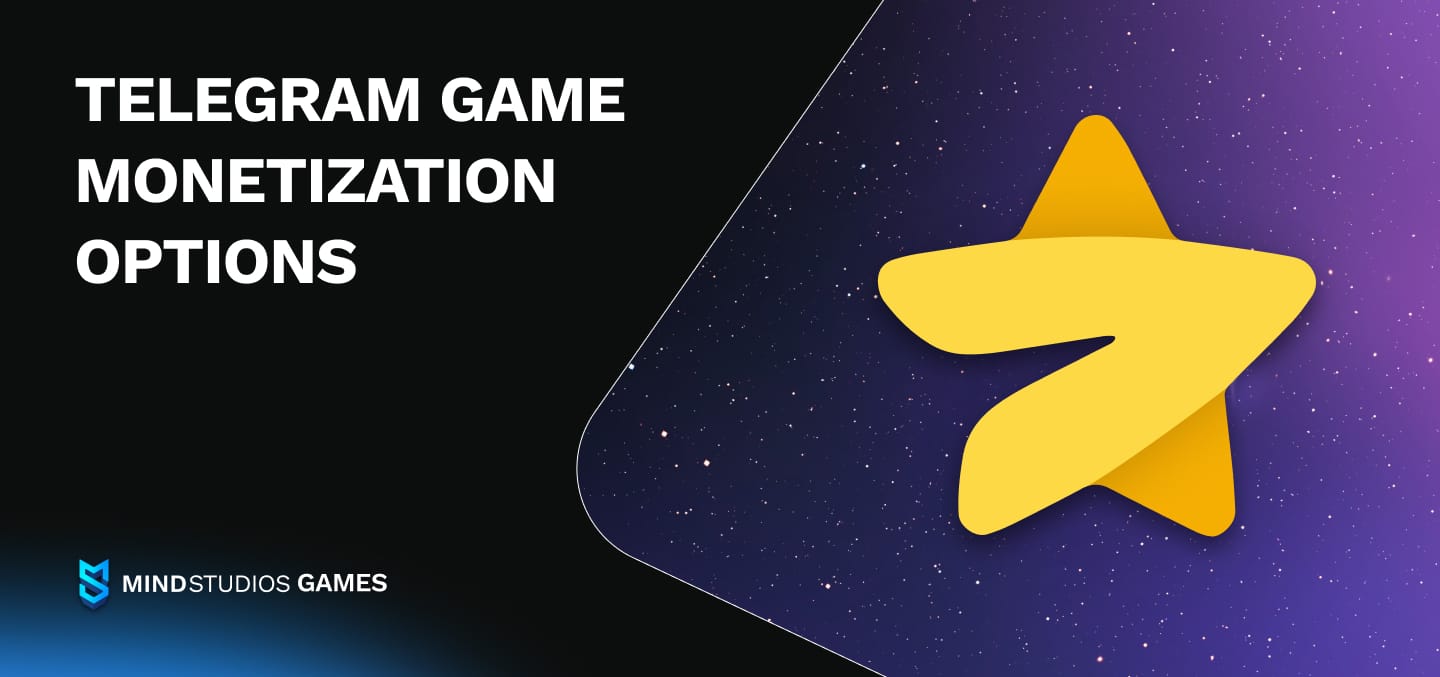
Monetization is an important aspect of game development, and Telegram games are no exception. (Game developers need to eat too.) Here are the options those interested in creating games for Telegram have:
Telegram game monetization options |
|
|---|---|
| Freemium / In-app purchases* | You can make the main game free and offer paid features: boosters, cosmetics, paid levels, etc. |
| Offerwalls / Tasks | A monetization model that’s been popular among mobile games and entertainment apps for several years already, it involves offering players in-game currency if they reach certain milestones playing other games. |
| Your own token | That’s what Hamster Kombat and several other crypto games did — they launched their own tokens and designed the games around those tokens. |
| Subscriptions* | Subscriptions are a type of IAPs which offer players bonuses like premium content or daily rewards. |
| Partnerships | You can integrate indirect ads into your game by adding branded content. For example, advertising a store with physical items by building its small digital version in the game |
| Donations / Tips | You can ask players to donate or tip you via in-game payments if they enjoyed the game. |
| Paid chatbot | A payment gateway can be linked to a Telegram bot, which allows you to offer players purchases without leaving Telegram. However, do pay attention to comply with the Telegram payment policies. |
*Note: If you decide to go with IAPs or subscriptions as your game’s monetization, this is done via Telegram Stars, Telegram’s own way to involve third party payment processors to allow users to make purchases and give gifts to other users.
Now, to implement all these monetization options, developers can use the official Telegram Payment API. It works like this:
- The user sends a message to a bot to start a purchase. For instance, they might select a product or enter an amount for a donation.
- The bot shows a payment form with details like the item, price, and any options (such as size or quantity).
- When the user confirms, the payment provider takes over to handle the secure processing.
- Once payment is successful, the bot receives confirmation, and the user gets a receipt or order confirmation.
- The bot (or the business behind it) can then complete the order, whether that means delivering a digital file, arranging for shipping, or unlocking a premium service.
This works for games as well as for other businesses, including offline ones like delivery.
TON integration
If you’re planning to build a play-to-earn game or introduce NFT, for example, you’ll need to integrate with The Open Network, Telegram’s cryptocurrency system.
TON is a decentralized blockchain originally developed by the Telegram team and now operated by an independent community of developers. Telegram itself has integrated TON into its ecosystem with features like TON Wallet, making it seamless to leverage this network in games on the platform.
Things players can do with TON include crypto exchange, NFT purchase and management, playing P2E games, and more — all without needing third-party payment solutions, using Toncoin. This simplifies the user experience, as players won’t have to leave the app to complete transactions.
How to integrate TON into your Telegram game? Here are 5 main steps.
- Integrate TON Wallet. Use Telegram’s TON Wallet integration to allow for in-game Toncoin transactions.
- Develop smart contracts. Work with TON smart contracts to manage in-game assets, rewards, and any player-to-player transactions.
- (optional) Build NFT functionality. Decide if and how NFTs will be used in the game and create a strategy for issuing, storing, and transferring NFTs using the TON blockchain.
- Design token economics. Plan out how Toncoin and NFTs will function in the game, including scarcity, trading, and reward systems.
- Use community engagement. Use TON for community building, giving players a say in the game’s evolution and encouraging a long-term community investment.
At Mind Studios Games, we have experience in developing blockchain-based games with NFTs and smart contracts, and we can adapt that experience to Telegram game development as well. If you’re looking for a partner to make your own P2E Telegram games, get in touch with us.
Popular Telegram-based games you can learn lessons from
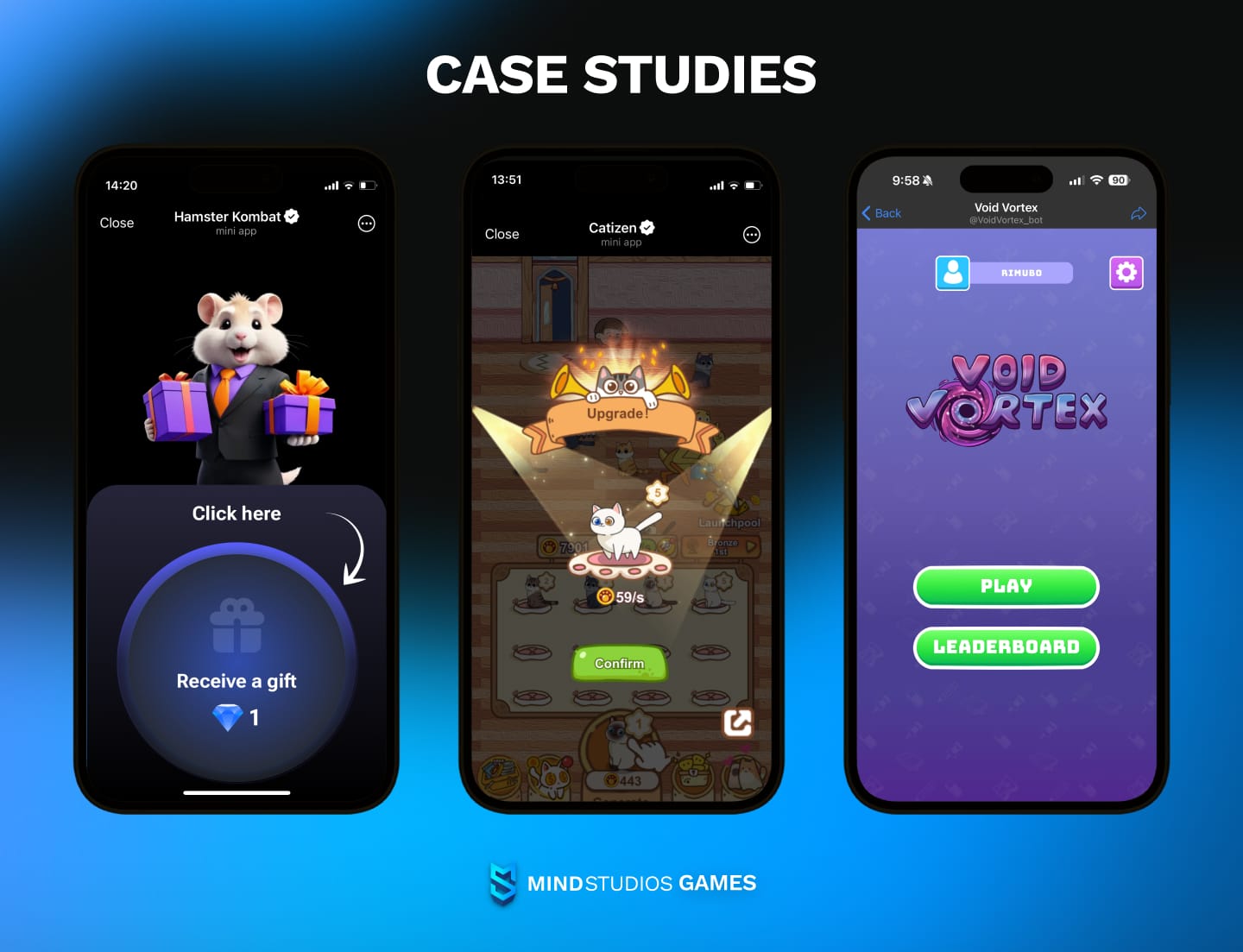
Telegram as a gaming platform is, for now, an emerging market, so huge success stories aren’t yet abundant. However, we do have a couple of case studies for successful Telegram game development.
Crypto — Hamster Kombat
We’ve mentioned this title several times in this article, and that’s for a reason — this game became the talk of town globally when it launched. Mainly, the key was the promise of rewards for active players when the game’s native cryptocurrency, the HMSTR token, was promised to launch (and it did).
The path wasn’t all smooth for Hamster Kombat’s developers. For one, the game's crypto focus presented challenges in educating users, especially those unfamiliar with cryptocurrency. To address this, Hamster Kombat created educational videos, step-by-step guides, and translated content into multiple languages, helping players navigate the crypto-based features of the game.
After the HMSTR token’s launch, there was also a controversy with the airdrop, where a large portion of players were accused of cheating, and therefore didn’t receive any rewards. Due to this (at least in part), the token’s value dropped 30% in the first 24 hours after its launch.
However, the developers did recover, and currently, Hamster Kombat is in its second season, and the team is planning to explore more platforms for the game, not just Telegram — by creating a progressive web app.
Hyper-casual — Void Vortex by Mind Studios Games
The game was initially developed primarily for mobile platforms. But when Telegram games started gaining momentum, we wanted to try creating a port of our game on Telegram — Void Vortex was a perfect fit for this. We developed a bot, added a leaderboard, deployed the WebGL game, and launched it in production. That was it. Now we’re ready for more 🤩
Void Vortex is a pretty simple game, functionality-wise. It’s a hyper-casual game with a single mechanic — moving a black hole around the area filled with differently sized items. The players need to move the hole in a way that more items fall inside. Some items are too big to fall in as they are, and players need to employ focused tactics to find a way to drop them anyway. Different levels have different items and themes to keep things interesting.
Crypto — Catizen
Another popular crypto-based game available on Telegram, this one is more of the cute-leaning titles, captivating players who love felines. It also features mechanics that are more casual than idle, compared to Hamster Kombat. You’d recognize it if you’ve ever played merge games like Merge Mansion (or you could have seen its interactive ads, as the campaign is quite extensive).
Catizen offers players to breed and evolve NFT cats by merging, and put them into a “cat café” where customers drop by to pet them for a fee. The game operates on a multi-token system integrated with the TON (The Open Network) blockchain, which includes vKITTY, Fishcoin, and CATI tokens. The vKITTY and Fishcoin are the basic tokens used to get upgrades. CATI is a tradeable token.
Tokens can also be earned via referrals to friends, airdrops, and being on the leaderboards. Players can also buy and sell cat NFTs on the game’s marketplace.
Text-based — Tetris Bot
Tetris Bot is a simple, text-based adaptation of the classic Tetris game. It garnered widespread popularity among Telegram users due to its simplicity and universal appeal.
Tetris is a highly visual game, and converting it to a text-based experience on Telegram, while maintaining its core mechanics and excitement, was a significant challenge for developers. Not deterred in the slightest, the team experimented with Telegram’s text features creatively, using symbols to represent blocks and communicate the game state. This minimalistic representation proved effective in conveying the game’s iconic falling block structure.
The text-based nature of the game allowed for quick, short sessions, perfect for casual gamers, so users remained engaged and willing to replay multiple times. Additionally, Tetris Bot made use of Telegram’s group functionality, enabling users to share their scores within groups and challenge others to beat them. This social aspect added replay value despite the game’s simplicity.
Conclusion
Telegram is steadily evolving into a super app like WeChat; it already offers multiple services besides messaging — channels, mini apps, bots, and games. And while Telegram is, for now, smaller than WeChat (it has about 700 million monthly active users compared to WeChat’s 1.3 billion), it has more reach: the vast majority of WeChat’s users are based in China, whereas Telegram is popular in Eastern and parts of Western Europe, Latin America, India, Middle East, and Central Asia.
What we’re trying to say here, if you want to develop a game and distribute it through a messenger platform, Telegram is a good option that seems to be growing every day. Besides, creating games for Telegram isn’t something completely novel, and a team of skilled game developers can handle it with ease. We can be such developers for you 😎
At Mind Studios Games, we have developers working with both HTML5 and Unity WebGL, and we know how to integrate a game into the Telegram bot too. Moreover, we also have experience with blockchain game development and NFTs, which are all the rage in Telegram these days. So contact us for a consultation, and let’s discuss your future banger of a game for Telegram 🤩

